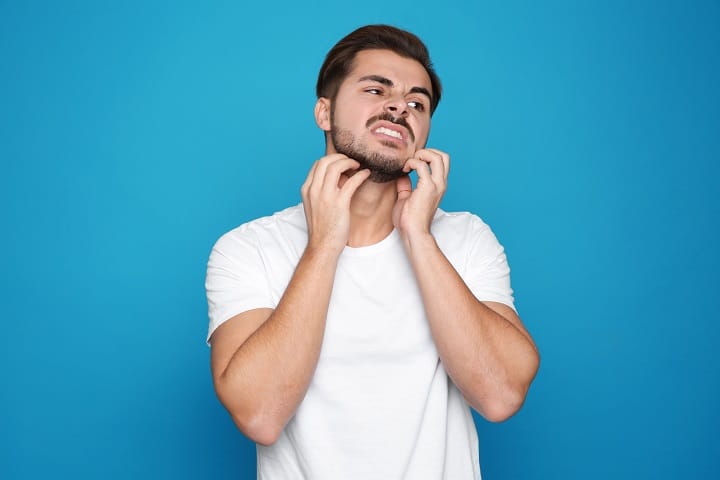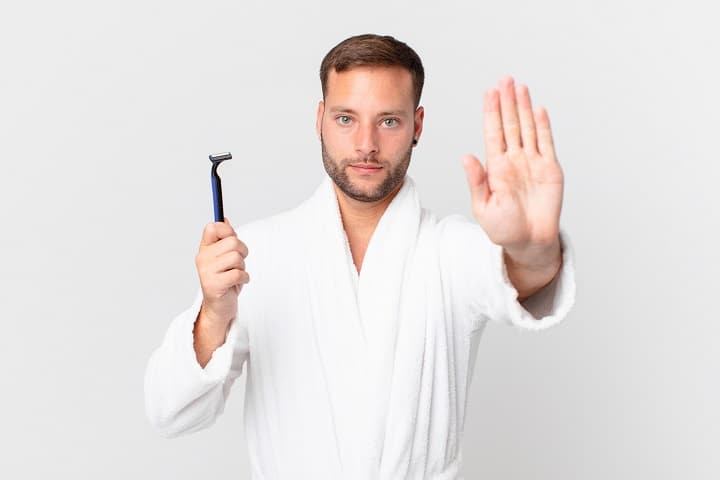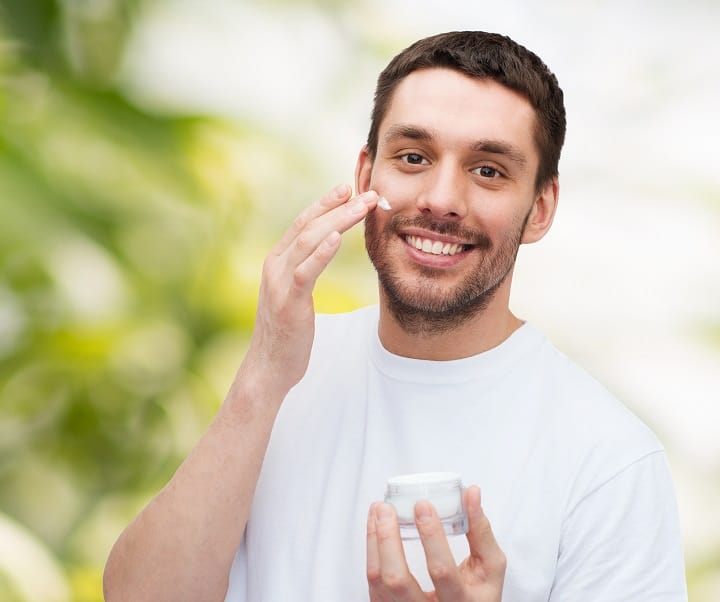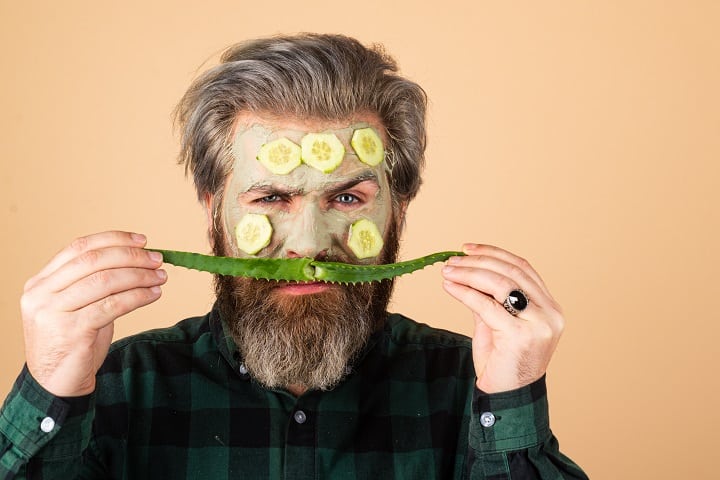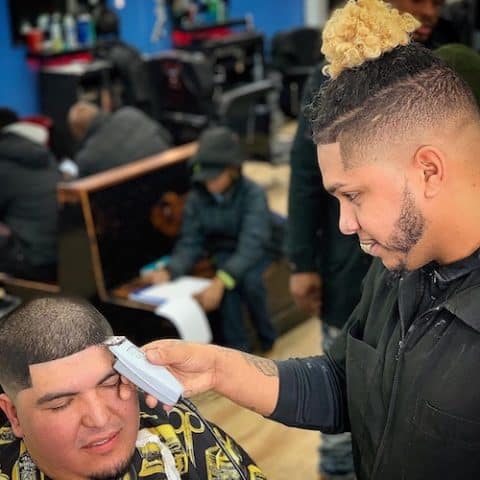Beard burn is a common problem that many men experience when growing a beard. It can be caused by dry skin, ingrown hairs, and chafing from the beard rubbing against the skin.
Luckily, there are several ways to prevent and treat beard burn. In that light, we will discuss what causes beard burn, its symptoms, and how to prevent it from happening. Let’s begin.
Table Of Contents
What Is Beard Burn
Beard burn is skin irritation in people who have grown facial hair. It usually appears as redness, itching, and sometimes blistering around the beard area of the face.
The cause of this condition can be dry, dead skin cells, or ingrown hairs in your beard. Both are common problems for guys with thick beards. The hair follicles can also become irritated from the constant friction of the beard rubbing against your skin.
In some cases, you may also get a beard burn from eating spicy foods or drinking alcohol. These products can irritate and inflame the sensitive skin around your mouth.
Causes
There are several ways that you can get a beard burn. The most common way is from the friction of your beard rubbing against your skin. This can cause redness, itching, and burning sensations in the affected area.
On the other hand, you can get a beard burn from dry, dead skin cells or ingrown hairs in your beard. Beard burn can also be caused by eating spicy foods and drinking alcohol.
So, this is a condition that many different things can cause. However, the most common cause is the friction of your beard rubbing against your skin.
This is especially true for people with long facial hair. The longer and thicker your beard, the more likely you will suffer from this condition.
Symptoms
The symptoms of beard burn can vary depending on the cause. However, the most common symptoms are:
- Redness
- Itching
- Burning sensations around the affected area (usually your beard)
You may also experience some other symptoms depending on the cause of your beard burn. For example, if you have dry, dead skin cells or ingrown hairs in your beard, they can be painful to touch and they may even bleed when scratched at itchy patches around them.
The symptoms of a beard burn caused by eating spicy foods or drinking alcohol are different. You may experience burning sensations in your mouth and throat, sweating, an elevated heart rate, and nausea.
These symptoms only last for a short period before the body adjusts itself to normal again. The good news is that you won’t need any treatment if this happens because it isn’t severe enough to cause any long-term damage.
Types
Type 1 – Irritated Hair Follicles
The first type is when the hair follicles become irritated from constant friction. This causes redness and itching around your beard area (usually where it rubs against your skin).
Also, if you have ingrown hairs, they will become more prevalent and noticeable in this type of beard burn.
Type 2 – Dry Dead Skin Cells
The second type occurs when you have dry, dead skin cells or ingrown hairs in your beard. They will make you feel uncomfortable if you touch them, and they will bleed when scratched around itchy regions.
On top of that, dead skin cells can cause other problems like acne breakouts, dandruff and even psoriasis.
How to Prevent
There are a few different ways to prevent beard burn from happening. The most important one is to keep your beard clean and well-groomed. This will help remove any dead skin cells or ingrown hairs present in your facial hair.
In addition, make sure to drink plenty of water and eat healthy foods. This will help keep your skin hydrated and healthy, crucial to avoiding beard burn.
Let’s see some of the best ways to keep your beard healthy and free of beard burn.
Skin Moisturizing
Your skin can become dry and itchy if you don’t moisturize it. This is especially important for those who are more sensitive to beard care products.
So, one way to prevent beard burn is by using a good quality moisturizer on your face every day before going out in public or working outside where there might be pollution or other irritants present in the air.
To make matters worse, these irritants can get into your pores, causing inflammation on the surface of your skin which will lead to itching and redness.
The best way to avoid this is by using an excellent natural skin care product like jojoba oil or shea butter for men before heading out every day (or as needed).
Cleaning
Cleaning your beard is essential for many things, not just to get rid of beard burn. If you don’t clean it regularly, bacteria and dirt will build up there, leading to infections like folliculitis or acne breakouts.
Therefore, ensure that you’re washing with warm water after using any beard care products (including shampoo). You should also exfoliate before or after shaving; it’s up to you.
Also, remember to clean your beard every time you get the chance properly. Some say that the safest way of doing this is by using a beard wash, but others recommend deciding between shaving soaps or creams.
It’s up to you which one works better for your skin type because everyone has different needs regarding what will work best in their situation.
Anyway, make sure that you’re cleaning your hair regularly to avoid beard burn.
Beard Softness
Another way to prevent beard burn is by making sure that your facial hair is soft and well moisturized. This will help lessen the chances of friction between itchy areas on your face or neck when rubbing against these parts of your body during normal activities like talking with friends, eating food and drinking beverages.
The best way to soften your facial hair is by applying beard oil regularly throughout the day. It’s also recommended to use natural ingredients like jojoba and argan oils because they’re great for hydration and softening dry skin.
You should always be careful when using products with chemicals in them since these can irritate some sensitive people out there who have allergies or other issues.
Beard oil is made up of ingredients like jojoba and argan oils, but if you’re allergic to either one, it’s best not to use them. They could cause an unwanted reaction in your face or neck area, which would lead to itching or redness from the irritation.
Another thing that you need to be aware of is that some beard oils contain essential oils, which can cause allergic reactions.
Trimming
If you have a long beard, it’s important to trim it on occasion; otherwise, all of that hair will rub against your skin and cause friction. This can lead to redness, rash-like symptoms, and even beard burn.
Therefore, use sharp scissors or clippers when cutting your facial hair and avoid using dull blades since these can cause more damage to your skin.
When it comes to trimming, always start with the longest hairs and work your way down to the shortest ones to avoid missing any spots. If needed, use a comb or brush to help you get a better view of what you’re doing before snipping away.
If you’re having a hard time figuring out how to trim your beard on your own, there are plenty of online tutorials that can help you out. Just make sure that you’re following the instructions correctly so that you don’t end up causing more harm than good.
Getting Close Shave
If you like to get a close shave now and then, you need to be extra careful. The razor blades can easily cause irritation and redness on your skin, especially if it’s already prone to beard burn.
To help prevent this, always make sure that you’re using a fresh blade and that the razor is moistened before going over your face with it. Also, you should never shave against the grain because doing so can lead to cuts or scrapes on top of any potential burns due to friction.
What’s more, always remember to apply shaving cream or gel before using your razor so that it glides over smoothly without causing any unnecessary damage. And, if you’re having trouble deciding between an electric razor vs. a blade, always go with the blade.
How to Treat
Step 1 – Apply a cold compress
If you’re experiencing any of the symptoms mentioned above, it’s best to start by applying a cold compress. This will help soothe any inflammation or itching that might be going on.
You can also try taking an over-the-counter medication like ibuprofen to reduce the bread rash, swelling, and pain associated with beard burn.
Step 2 – Use moisturizer
Once you’ve taken care of the inflammation, it’s time to apply a good amount of moisturizer to your face to prevent any further irritation from occurring.
For best results, we suggest using an all-natural product like coconut oil or shea butter because these will help lock in moisture without clogging up your pores. So, when it comes to beard balm vs. beard butter, you should always go with beard butter.
Step 3 – Stop shaving
If you’re still experiencing symptoms even after taking these steps, it’s probably best to stop shaving altogether until things clear up.
This means no more facial hair trims and definitely no going over the same area again with your razor blade so as not to cause any further irritation or damage that could lead to infection down the road.
Step 4 – Wait it out
Once your skin has healed enough, you can resume shaving as usual, but remember not to go over the same area too often to cause any irritation or redness again.
Also, take care when trimming around sensitive areas such as under your nose and near your mouth so that they don’t get caught up in a razor blade while you’re trying to shave off those pesky hairs.
If none of these treatments work, it might be time to visit the doctor or dermatologist who can give you some advice on how best to treat your beard burn.
Best Products
Moisturizer
Beard oil is a great way to keep your skin moisturized without clogging up pores or causing breakouts. If you have sensitive skin that reacts poorly with other products like lotion, this might be what the doctor ordered to treat beard burn!
To use this product, apply a small amount of beard oil onto your face before shaving in the morning and evening. You can also rub it into any rashy areas after washing off with soap to help soothe irritation caused by razor burn or other dryness.
Beard balm is another moisturizing solution that works well for treating beard burn. It’s a bit thicker than beard oil and is made with natural ingredients like beeswax, shea butter, and jojoba oil that help to soothe and protect the skin.
To apply, scoop out a small amount of balm using your fingers and rub it into your hands until it’s melted. Then, massage it into the beard area where you have rashy spots or irritation caused by razor burn.
Furthermore, the leave-in beard conditioner is a particular type of product designed to help treat and heal your skin after shaving.
It contains ingredients like coconut oil, shea butter, and jojoba oil which are known for their ability to moisturize without clogging pores.
All in all, these products are great for keeping your skin healthy and preventing irritation caused by beard burn.
You can use one or more of them depending on what works best for you as an individual. However, we recommend starting with premium beard oil first since it’s the most versatile product available (and easiest to apply).
If you might be allergic to beard oils, you can use some oil-free moisturizer for men.
Chafing Cream
If you’re experiencing a lot of irritation and redness from shaving, then chafing cream might be the best solution for you. This type of product is designed to help soothe skin burned or inflamed due to friction.
To apply, rub a small amount into the affected area after showering or shaving. You can also use it as a preventative measure by applying it before going out in hot weather or during activities that might cause skin irritation.
This product is especially great for sensitive skin people since it can help reduce pain caused by razor burn, ingrown hairs, and other forms of irritation.
Petroleum Jelly
Another option for treating beard burn is petroleum jelly. This thick, white substance is made from mineral oil and helps to create a barrier between the skin and the environment.
This can help prevent further irritation and help speed up the healing process.
To apply, scoop out a small amount of petroleum jelly using your fingers and rub it into the beard area where you have rashy spots or irritation caused by razor burn. You can also put a small amount on a cotton ball and dab it onto the affected areas for extra relief.
However, petroleum jelly should not be used as a long-term solution since, over time, it can clog pores and cause breakouts.
Topical Hydrocortisone
Topical hydrocortisone is a steroid that can treat inflammation and irritation. It’s also an effective treatment for skin conditions like eczema or psoriasis, which often occur in people with sensitive skin types.
To apply this product, you don’t need much effort. Apply a thin layer of topical hydrocortisone cream onto your skin and leave it on for about 15 minutes. This will help soothe any redness or irritation caused by razor burn while simultaneously healing the affected area at the same time.
However, you should avoid using this product more than once in 24 hours. Also, this is a product that’s recommended only when the beard burn gets way out of hand.
Quick Tips on How to Avoid Them
If you ever be in doubt to shave or not to shave your beard in case you have a beard burn, it’s a good idea to check out our quick tips.
Here are some of the most important things you should consider to avoid beard burns.
- Shave in the direction of hair growth. This will help reduce the amount of tugging and pulling on your skin, which can cause razor burn.
- Apply a thin layer of lubricant before shaving. This will help create a barrier between the blade and your skin, reducing getting razor burn.
- Avoid shaving too close to the skin. Shaving too closely can cause irritation and razor burn. Try to keep the blade at least ¼ inch away from your skin for a closer shave without any burns.
- Replace blades often. Dull blades can cause more tugging and pulling on your skin, which will increase your chances of getting razor burn. Replace blades at least every five to seven shaves.
- Always apply quality aftershave. With the best aftershave, you can diminish the appearance of beard burn and razor bumps.
Beard burn can be a real pain, both literally and figuratively. But by using some of the methods we’ve talked about in this article, you can help reduce the chances of it happening. So don’t let beard burn keep you from looking your best – follow these tips and you’ll be good to go.
Do’s and Don’ts
Do’s
- Apply a cold compress. This can help soothe the skin and reduce inflammation.
- Do apply a topical cream or ointment. This can help speed up the healing process.
- Drink plenty of water. This will help keep your skin hydrated and reduce inflammation.
- Check your shaving tools. It’s essential to check your razor if you get a beard burn. You can sometimes find that the razor is the cause of the burn.
Don’ts
- Don’t shave until the beard burn goes away. Shaving can further irritate the skin and delay the healing process.
- Don’t use hot water when showering. Hot water can cause further irritation to already inflamed skin. Use lukewarm or cool instead!
FAQ
What natural remedy can I use for a beard burn?
If you want to use a natural remedy for beard burn, consider using aloe vera gel. Aloe Vera is an excellent treatment because it has anti-inflammatory properties and can help soothe the skin. You can apply this gel directly onto your face after shaving or purchase an over-the-counter product that contains aloe vera.
What are the dangers of genital beard burn?
In most cases, genital beard burn is the same as facial. However, there are some other dangers you could face regarding your genital area. The most common one is ingrown hair, rash, and irritation.
How long does it take for beard burn to go away?
If appropriately treated, beard burn will go away in days. Beard burn can also be quite dangerous if it’s not treated correctly. If the burn is severe, it could lead to scarring or even infection. So make sure you take care of any beard burns as soon as possible!
Should I see a doctor because of a beard burn?
In most cases, beard burn can be treated at home. However, if you have any questions or concerns about your beard burn, it’s always best to consult a doctor. A doctor will be able to provide you with the proper treatment and advice on how to take care of your beard burn.
How can I soften my beard to prevent beard burn?
One way to help soften your beard and reduce the chances of getting a beard burn is by using a conditioner. A quality conditioner will help make your beard more manageable and less likely to catch on fire. You can also try applying light oil such as jojoba oil to your beard before shaving. This will help the blade glide over your skin and reduce irritation.
Conclusion
If you are currently experiencing beard burn, we hope the tips in this post have given you some relief. Remember to be gentle when treating the area and give it time to heal.
If the condition persists or worsens, please see a doctor. For all of our bearded friends out there, remember to take care of your skin and keep that face looking handsome!
Jay is one of the members of the Beardoholic writers team and NFL, celebrity barber. As a master barber with years of experience, Jay can make your beard look any way you envision. Jay’s specialty is black men’s hair and beard styles, but he also has deep knowledge on how to create a perfect neck and cheek line, short or long beard and virtually any beard and hair shape and style.


